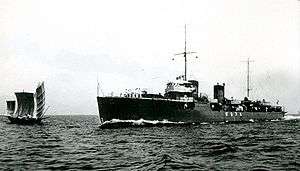Japanese destroyer Yūkaze
 Yūkaze commissioning at Nagasaki, 1921 | |
| History | |
|---|---|
| Name: | Yūkaze |
| Ordered: | fiscal 1918 |
| Builder: | Mitsubishi-Nagasaki, Japan |
| Laid down: | 14 December 1920 |
| Launched: | 28 May 1921 |
| Commissioned: | 24 August 1921 |
| Struck: | 5 October 1945 |
| Fate: | Royal Navy 1947-later scrapped |
| General characteristics | |
| Class and type: | Minekaze-class destroyer |
| Displacement: |
|
| Length: |
|
| Beam: | 9 m (30 ft) |
| Draught: | 2.8 m (9.2 ft) |
| Propulsion: | 2-shaft Mitsubishi-Parsons geared turbines, 4 boilers 38,500 ihp (28,700 kW) |
| Speed: | 39 knots (72 km/h) |
| Range: | 3,600 nautical miles (6,700 km) at 14 knots (26 km/h) |
| Complement: | 148 |
| Armament: |
|
| Service record | |
| Operations: | |
Yūkaze (夕風 Evening Wind)[1] was a Minekaze-class destroyer, built for the Imperial Japanese Navy immediately following World War I. Advanced for their time, these ships served as first-line destroyers through the 1930s, but were considered obsolescent by the start of the Pacific War.
History
Construction of the large-sized Minekaze-class destroyers was authorized as part of the Imperial Japanese Navy's 8-4 Fleet Program from fiscal 1917-1920, as an accompaniment to the medium-sized Momi class with which they shared many common design characteristics.[2] Equipped with powerful engines, these vessels were capable of high speeds and were intended as escorts for the projected Amagi-class battlecruisers, which were ultimately never built.[3] Yūkaze, built at the Mitsubishi shipyards, Nagasaki, was the tenth ship of this class. The destroyer was laid down on 14 December 1920, launched on 28 May 1921 and commissioned on 24 August 1921.[4]
On completion, Yūkaze was assigned to Yokosuka Naval District as part of Destroyer Division 3 under the IJN 2nd Fleet. On 11 October 1928, in Uraga Channel, while on night training maneuvers, Yūkaze collided with her sister ship Shimakaze, resulting in significant damage and requiring extensive repairs.
In 1937-1938, Yūkaze was assigned to patrols of the central China coastlines in support of Japanese efforts in the Second Sino-Japanese War
World War II history
At the time of the attack on Pearl Harbor, Yūkaze was under Carrier Division 3 in the IJN 1st Fleet based at the Kure Naval District as part of the escort for the old aircraft carrier Hōshō. As such, the destroyer participated in the Battle of Midway.[5]
Afterwards, Hōshō was used to train naval aviators, remaining in the Inland Sea under the IJN 3rd Fleet, and Yūkaze continued to serve as the aircraft carrier's escort through the end of World War II.[6]
On 5 October 1945 Yūkaze was removed from navy list.[7]
After the war, Yūkaze was used as a repatriation vessel from October 1945 through August 1947, when the ship was turned over to the British Royal Navy as a prize of war in Singapore, where it was broken up for scrap.
Notes
- ↑ Nelson. Japanese-English Character Dictionary. pages 283, 960
- ↑ Howarth, The Fighting Ships of the Rising Sun
- ↑ Globalsecurity.org, IJN Minekaze class destroyers
- ↑ Nishidah, Hiroshi (2002). "Minekaze class 1st class destroyers". Materials of the Imperial Japanese Navy.
- ↑ http://www.microworks.net/PACIFIC/orders_of_battle/midway_japan.htm
- ↑ Nevitt, Allyn D. (1997). "IJN Yukaze: Tabular Record of Movement". Long Lancers. Combinedfleet.com.
- ↑ Nishidah, Hiroshi (2002). "Minekaze class 1st class destroyers". Materials of the Imperial Japanese Navy.
References
- Howarth, Stephen (1983). The Fighting Ships of the Rising Sun: The Drama of the Imperial Japanese Navy, 1895-1945. Atheneum. ISBN 0-689-11402-8.
- Jentsura, Hansgeorg (1976). Warships of the Imperial Japanese Navy, 1869-1945. US Naval Institute Press. ISBN 0-87021-893-X.
- Nelson, Andrew N. (1967). Japanese-English Character Dictionary. Tuttle. ISBN 0-8048-0408-7.
- Watts, Anthony J (1967). Japanese Warships of World War II. Doubleday. ASIN B000KEV3J8.
- Whitley, M J (2000). Destroyers of World War Two: An International Encyclopedia. London: Arms and Armour Press. ISBN 1-85409-521-8.
External links
- Nevitt, Allyn D. (1997). "IJN Yukaze: Tabular Record of Movement". Long Lancers. Combinedfleet.com.
- Nishidah, Hiroshi (2002). "Minekaze class 1st class destroyers". Materials of the Imperial Japanese Navy.
- Jones, Daniel H. (2003). "IJN Minekaze, Kamikaze and Mutsuki class Destroyers". Ship Modeler's Mailing List (SMML).